Strategies for Making Tens
Est. Class Sessions: 2Developing the Lesson
Part 1. Explore Making-Tens Strategies
Use Cubes to Make Ten. Ask students to solve 14 + 7 + 6 with connecting cubes. They can use a different color to represent each addend. Ask students to group the cubes in as many tens as possible to achieve the sum. One way to find the sum:
- Break apart the fourteen into ten and four;
- Group the six cubes with the four cubes to make a ten;
- Represent the sum with two trains of ten cubes and a train of seven cubes.
Ask students to share their methods; then pose the following questions to the class:
Switching Numbers. Explain that there is a mathematical rule that says the order in which we add numbers in a number sentence does not matter. The addends can be rearranged or switched any way you want without affecting the sum. (It is not important for students to know the name of this rule as the Commutative Property of Addition at this time.) Call this switching numbers. Remind students that number sentences are easier to solve if the order of the addends are first rearranged or switched to find groups of ten or by making a multiple of ten.
Challenge students to complete 14 + 7 + 6 using the making-tens strategy.
Ask:
Give students other problems:
8 + 7 + 12
6 + 8 + 14
11 + 3 + 9
Encourage them to find groups of tens with the cubes and then do the arithmetic mentally. Note that other strategies can be equally efficient. For example, students may choose to use doubles to add 6 + 8 + 14 = 14 + 14 = 28.
Refer students to Questions 1–6 on the Strategies for Making Tens pages in the Student Guide. Ask students to solve each problem and explain to their partner how they did the problems.
Breaking Addends into Parts. Explain to students that sometimes addends can be easily grouped into tens; however, groups of ten are not always easily found in a number sentence. Explain that, in this case, an addend can be broken into parts to help make a ten with other addends in the number sentence. Show students the following:
7 + 5 + 2
7 + 3 + 2 + 2
Use a “think aloud” technique to explain how you broke addends into parts to make a ten.
Demonstrate with connecting cubes as you point to the appropriate step in the display and say:
Ask:
Remind students to try to break addends into parts so that a ten can be made with at least one of the other addends in each number sentence.
Ask student pairs to solve and discuss similar problems. Ask students to show how they break apart the addends and make ten with the connecting cubes.
6 + 8 + 3
9 + 7 + 2
4 + 9 + 3
As students become adept at partitioning single-digit numbers, introduce two-digit addends in problems such as:
11 + 5 + 3
2 + 19 + 5
12 + 9 + 15
As a class, compare and share strategies.
As students share, ask:
Ask students to work in pairs to discuss and complete Questions 7–12 in the Breaking Addends into Parts section in the Student Guide. Tell students to be prepared to share their partner's strategy to any one of the questions. When students are ready, ask some students to share their partner's strategy with the class.
Assign the Switch It! Homework page in the Student Activity Book.















